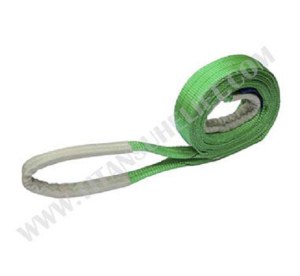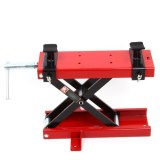TITANSUHE produces slings and rigging that are to be used with lifting equipment or crane for positioning, lifting, and transferring large loads. These sling lift and rigging can be categorized into three general types according to their construction and materials: chain slings, polyester slings, and wire rope slings. Sling lifting straps are more used for short-length material handling or road rescues. Polyester slings are widely used in applications that need soft touch and protection to the load's surface. Wire rope slings can be engineered with extremely long lengths, suitable for long-distance material and equipment handling such as bridge and building constructions.
Lifting Slings Types for Sale
Polyester Slings
Webbing Slings and round slings are usually used to lift loads that need protection from damage. These polyester webbing slings are specially designed to carry heavy loads and lift them safely. It's very strong yet lightweight, and its flexibility reduces shock when loading. They come out with bright colors and easily to identify their capacity on body.
Chain Sling
The chain sling is a very sturdy chain hook tool. Rigging lifting straps are available with grade 100 or grade 80 chain that combined with different accessories to form one, two, three or four chain legs. Hooks with different ends and chain lengths are used for various construction or industrial sites.
Wire Rope Sling
Wire ropes are often made into different forms of slings for the lifting industry due to their high strength, durability and wear resistance.
Why Choose Titansuhe be your lifting slings suppliers?
Each chain links and chain components are tempered and quenched to get high strength and abrasion resistance for overhead lifting.To make chains fit properly with hooks or hoists also get each link calibrated before delivery. G80 chain can be used in any rigging application that requires a 30-80 grade chain. To identify class 80 slings and lifting chains, all chains are marked with embossed G80 on body. This do good for your checking during usage. The chain components are also completed through a rigorous inspection process and testing procedure to ensure that the end user gets a quality chain sling.
Safe Use of Hoists and Slings
Determine the load weight and be sure it's within the rated capacity of the sling.
Chose rigging slings that have suitable characteristics for the type of load, hitch and environment.
Never use lifting slings exceeding its rated capacity. When using 2 leg or multi-leg slings, the load angle will affect the rated load. See load chart below.
Lifting slings with fittings which are used as a choker hitch shall be of sufficient length to assure that the choking action is on the slings and never on a fitting.
When using lifting slings in a basket hitch, be attention to balance the load and prevent slipping.
Be sure the fittings have proper shape and size of the opening that can seat properly in the hook or other attachments.
Keep rigging slings away from the sharp corners, sharp edges that may cut or damage the slings, protrusions or abrasive surfaces.
Do not drag slings on the floor or over an abrasive surface.
Do not twist or tie slings into knots or join slings by knotting.
Do not pull slings from under loads if the load is resting on the sling.
Do not drop slings equipped with metal fittings.
Do not use slings that have damages or defect unless it is inspected and accepted by qualified person.
When use slings in hitched, it should be able to control the load.
Always stand clear from between the sling and the load, and from between the sling and the crane hook or hoist hook.
Always keep personnel away from the suspended load.
Do not allowed personnel ride the sling.
Do not shock loading.
Do not twist and kink the sling legs.
Always center the load in the hook bowl to prevent point loading on the hook.
During lifting, with or without the load, personnel shall be alert for possible snagging.
When using slings a basket hitch, always contain and support the load from the sides above the gravity center.
Always pay attention to the angle of the legs and select slings with enough length to provide adequate rated capacity.
Place blocks under load prior to setting down the load, to allow removal of the slings, if applicable.
Do not use Nylon or duplex polyester webbing sling at temperatures above of 194 degrees F (90 degrees C).
Do not expose the polyester slings under sunlight or ultra-violet light which will degrade the strength of the slings. Always keep slings in a dry, cool and dark place when not in use.
In choker hitch, slings shall be long enough so that the choker lifting chokes onto the sling eye or body and never onto any fittings.
Do not use slings at angles of less than 30 degrees from horizontal.
Inspection Before Buy Lifting Slings
A. Initial Inspection
Before placing any new or repaired slings in service, always inspect the sling and be sure that the correct sling is being used, and the sling meets the requirements of this specification and has not been damaged in shipment.
Failure to read, understand and follow the use and inspection instructions with each sling may result in severe personal injury or death
B. Frequent Inspection
Before each using, inspect the slings by a qualified person.
C. Periodic Inspection
Periodically inspect the slings by a designated personnel base on following information.
1. Sling using frequency
2. Sling service condition
3. Sling service life
4. Periodic inspections should be conducted at least monthly
Angle and Load Chart of Lifting & Rigging Slings
ANGLE is measured between a horizontal line and the sling leg or body. This angle is very important and can have a dramatic effect on the rated capacity of the sling. As illustrated, when this angle decreases, the load on each leg increases. This principle applies whether one sling is used to pull at an angle, in a basket hitch or for multi-legged bridle slings. This data is only for equally loaded sling legs. Sling angles of less than 30 degrees are not recommended.
|
Sling Angle in Degrees
|
Factor
|
|
90
|
1.000
|
|
85
|
0.996
|
|
80
|
0.985
|
|
75
|
0.966
|
|
70
|
0.94
|
|
65
|
0.906
|
|
60
|
0.866
|
|
55
|
0.819
|
|
50
|
0.766
|
|
45
|
0.707
|
|
40
|
0.643
|
|
35
|
0.574
|
|
30
|
0.500
|
Products
Lifting Tools and Equipment
Chain Hoist
Wire Rope Hoist
Trolley & Clamps
Lifting Clamps
Lifting Jack
Lifting & Rigging Slings
Polyester Slings
Chain Sling
Wire Rope Sling
Wire Rope Winches
Material Handling Equipment
Rigging Equipment
Tools & Hardware
Elevator
Removal Lifting & Rigging Slings From Service
Removed slings from service if any of the following are visible:
Sling tag information is missing or not readable.
Acid or alkalis burns.
Melting, charring or weld spatter of any part of the sling.
Holes, tears, cuts, snags or embedded particles.
Broken or worn stitching in load bearing splices.
Excessive abrasive wear.
Knots in any part of the sling.
Distortion, excessive pitting,corrosion or broken fittings.
Any conditions which cause doubt as to the strength of the sling.
Metal Fittings that are cracked, deformed, including melting or charring.
Hooks with throat openings increased by more than 15 percent or twisted out of plane more than 10 degrees.
If you need any kinds of lifting products, please contact us, as one of the most professional lifting equipment manufacturers, TITANSUHE is willing to offer you high quality products.
Location : 8-3, A Tower, Xiexing Building, No.59, Hongjin Road, Yubei District, Chongqing, China, 401147 Chongqing,
Contact : LIU Ammy, 86 23 67109618








